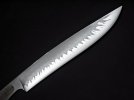- Joined
- Dec 8, 2008
- Messages
- 9
Hello,
I have a question towards creating a hamon line....
My knives and swords are usually made from steel that I pick up here and there... I judge the carbon content from the sparks that are visible when I grind at an edge of the steel.
My recent project is an early medieval seax that I forged from a huge old file. The carbon content is quite high, as it always is in files. The steel is great for knives, but on a sword like this, I fear it might get to brittle if I fully quench it. Also, differential hardening with its hamon line would make the blade more attractive. There have been investigations on such blades from archaeological context, which showed that they were indeed differentially hardened.
Now, finally I am coming to my question: Since the carbon content is high, will an oil quench suffice to create a hamon? I trust oil better than water on these high carbon steels, so I'd prefer an oil-quench... But will it produce a nice hamon? Can you say, that on softer steels you will need a more brutal quench, and vice versa?
I hope someone can help, thanks in advance.
I have a question towards creating a hamon line....
My knives and swords are usually made from steel that I pick up here and there... I judge the carbon content from the sparks that are visible when I grind at an edge of the steel.
My recent project is an early medieval seax that I forged from a huge old file. The carbon content is quite high, as it always is in files. The steel is great for knives, but on a sword like this, I fear it might get to brittle if I fully quench it. Also, differential hardening with its hamon line would make the blade more attractive. There have been investigations on such blades from archaeological context, which showed that they were indeed differentially hardened.
Now, finally I am coming to my question: Since the carbon content is high, will an oil quench suffice to create a hamon? I trust oil better than water on these high carbon steels, so I'd prefer an oil-quench... But will it produce a nice hamon? Can you say, that on softer steels you will need a more brutal quench, and vice versa?
I hope someone can help, thanks in advance.


